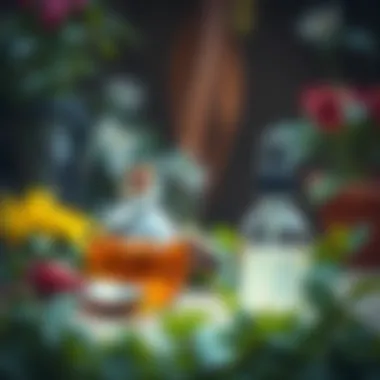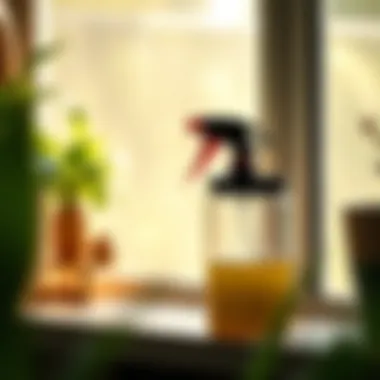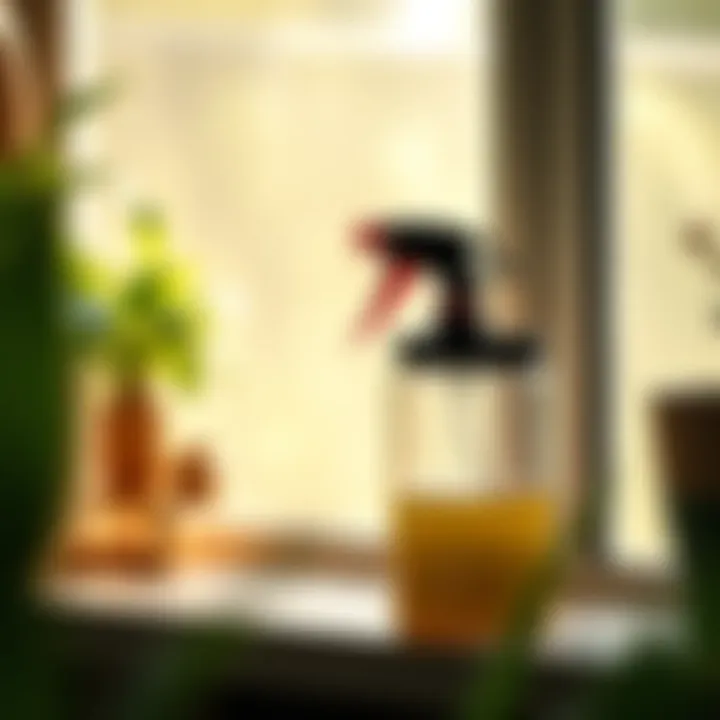DIY Mosquito Spray Solutions for Home and Garden


Intro
In the battle against pesky mosquitoes, understanding the nuances of do-it-yourself mosquito sprays is essential for any homeowner or gardening enthusiast. These flying nuisances not only disrupt outdoor gatherings but can also pose health risks through disease transmission. Rather than solely relying on commercial products loaded with chemicals, tapping into natural ingredients offers a sustainable and effective alternative.
This article guides you through the myriad recipes and strategies for crafting your own mosquito spray, with a focus on preparation methods, application techniques, and crucial safety precautions. Whether you are lifting a glass of iced tea on your patio or tending to your beloved plants, these sprays promise to make your environment more comfortable and enjoyable. Let's dive right into the effective designs and concepts that can inspire your DIY mosquito spray journey.
Understanding Mosquito Behavior
Understanding how mosquitoes behave is vital for anyone looking to fend off these pests effectively. Mosquitoes are not just random nuisances; they're guided by certain patterns and preferences which can be manipulated to enhance the efficacy of your DIY mosquito sprays. Knowledge about their habits can lead to targeted strategies that minimize their presence in your living spaces.
Why Mosquitoes Infest Areas
Mosquitoes are attracted to environments where they can thrive, often leading them to infest specific areas. These creatures have a knack for pinpointing regions abundant with food sources, particularly carbon dioxide emissions associated with human and animal respiration. Warmth plays a crucial role too; when the sun sets, the temperature often changes in a way that's inviting for these pests.
Several factors can contribute to mosquito infestations:
- Stagnant Water: Mosquitoes breed in standing water. Even the smallest puddles can serve as breeding grounds. It's essential for homeowners to regularly check for and eliminate any stagnant water around their property.
- Vegetation: Thriving gardens or overgrown areas provide shelter and attract more mosquitoes. Dense foliage also retains humidity, which is ideal for their survival.
- Nearby Animal Presence: Animals, particularly pets, can increase the mosquito population as they attract these insects through smells and movements.
Life Cycle of a Mosquito
The life cycle of a mosquito includes four distinct phases: egg, larva, pupa, and adult. Each stage presents opportunities for mosquito control strategies.
- Eggs: Female mosquitoes lay thousands of eggs in or near water sources. These eggs can survive if water isn't immediately available, making them a persistent issue during the wetter months.
- Larvae: Once in the water, the eggs hatch into larvae, which feed on organic matter. This stage lasts for about a week, depending on environmental conditions.
- Pupae: After the larval stage, mosquitoes enter the pupal phase. Here, they undergo a transformation, eventually emerging as adults. This stage generally lasts a few days.
- Adults: Adult mosquitoes spend most of their lives searching for food, and blood meals are essential for females to produce more eggs. Understanding this cycle can help in determining the best times to apply DIY sprays.
Preferred Habitats and Seasons
Mosquitoes tend to prefer specific habitats based on seasonal changes and environmental conditions. Warmer months often see a surge in their numbers. Here’s a breakdown of their preferences:
- Hot and Humid Conditions: Summer is peak season for mosquitoes due to higher humidity levels and ample stagnant water sources.
- Environment: Mosquitoes ideally seek out areas such as marshes, wetlands, and standing water in gardens. They are also frequently found in densely vegetated zones where they have cover.
- Active Times: Mosquito activity peaks during dawn and dusk when they are more likely to encounter humans and animals. Recognizing these patterns is crucial for determining when to apply DIY sprays for maximum impact.
By understanding these factors—how mosquitoes infest areas, their life cycle, and their preferred habitats—you can craft effective mosquito control strategies. This knowledge allows the implementation of effective and timely home remedies designed to keep these unwanted guests at bay.
Benefits of DIY Mosquito Sprays
Crafting your very own mosquito spray can be a game changer for anyone tired of these pesky insects. The advantages that come with creating a DIY spray far surpass merely keeping mosquitoes at bay; they encompass financial savings, health benefits, and environmental considerations.
Cost-Effective Solutions
One cannot ignore the financial appeal of do-it-yourself mosquito sprays. Store-bought solutions can leave a dent in one’s wallet, especially for families or those living in mosquito-prone areas. A few bottles from the local store can quickly add up, while DIY alternatives often utilize common household items—making them far easier on the purse strings.
To illustrate, consider the cost of citronella candles. Not only are they typically overpriced, but they burn out, requiring multiple purchases. Comparatively, a homemade version using citronella oil, mixed with water, can be made for just a couple of dollars—not to mention it lasts longer too!
"By tapping into your resourceful side, you can concoct potent sprays that don’t leave your finances in disarray."
Here’s a simple breakdown:
- Store-Bought Spray: $10 for a decent size bottle.
- DIY Spray: $3 for essential oils and water, lasts much longer.
This clear divide in costs makes DIY mosquito sprays a smart choice for budget-conscious homeowners and gardening warriors alike.
Natural Ingredients and Health Considerations
With the rise in natural living, many folks are leaning toward safer, non-toxic alternatives for everyday products. Pre-packaged mosquito sprays often come laden with chemicals that can irritate skin or lead to other health issues. Many find themselves recoiling from unpleasant scents and the potential for allergic reactions.
In contrast, the ingredients for DIY sprays often include natural oils, such as lavender and eucalyptus, that not only repel mosquitoes but can also promote a sense of calm when inhaled. Home mixes like these tend to be easier on the body, adding another layer of appeal to the concept of DIY mosquito control.
It’s worth paying careful attention to what goes into your sprays, as natural does not automatically mean harmless. Allergies to certain oils can exist; hence, a patch test is advisable. For example, lavender oil is generally safe for most but may cause reactions in rare cases.
Environmental Impact of Store-Bought Products
Considering the environmental implications of the products we use is vital in today’s eco-conscious era. Most commercial mosquito sprays contain synthetic chemicals that can wreak havoc not just on insects but on the environment as well. These products often come in plastic bottles, add to landfill waste and may adversely affect local ecosystems.
On the other hand, DIY sprays can truly shine in this category. By steering clear of harmful chemicals, we help protect pollinators and other beneficial creatures. Natural solutions, crafted with minimal environmental footprint, resonate well with those striving to live sustainably.
Some key environmental benefits of DIY sprays include:
- Reduced Chemical Pollution: The absence of synthetic additives helps keep waterways clean.
- Less Plastic Waste: Glass or reusable bottles can reduce dependence on single-use plastics.
- Preservation of Biodiversity: Natural sprays do less harm to local flora and fauna.
As we strive for greener options, opting for homemade solutions becomes not just a personal choice, but a step towards wider ecological responsibility.
Essential Ingredients for Homemade Mosquito Sprays
Creating effective DIY mosquito sprays requires understanding the right ingredients to use. These ingredients play a crucial role in repelling those pesky insects while ensuring safety for humans and pets. Each ingredient brings its unique properties, functionality, and fragrance, which ultimately enhances the overall effectiveness of the spray. By researching and selecting the right components, one can tailor their sprays to be both potent against mosquitoes and gentle on the environment.
Common Essential Oils
The backbone of any DIY mosquito spray often lies in essential oils. Many of these oils have natural repellent properties that effectively deter mosquitoes while providing a pleasant scent. Let’s delve into some of the most popular essential oils used in mosquito sprays.


Citronella Oil
Citronella oil is often hailed as a top choice in the war against mosquitoes. This oil, derived from the leaves of different species of grass, has a strong citrus scent that mosquitoes find unappealing. One of the key characteristics of citronella is its ability to mask scents that attract mosquitoes, making it an effective barrier. Its popularity springs not only from its efficacy but also its natural origin, drawing homeowners looking for natural solutions. However, it’s important to note that its effects can be short-lived, requiring reapplication more frequently than synthetic alternatives.
Lavender Oil
Lavender oil is not just a fragrant addition to your home; it's also a formidable mosquito deterrent. Its soothing scent is known to promote relaxation, but mosquitoes are not fans of its aromatic qualities. This dual role makes it a beneficial choice for families looking to create a calming yet mosquito-free environment. The unique feature of lavender oil lies in its anti-inflammatory properties, which can help soothe skin irritations from mosquito bites if they do occur. Although it’s generally well-tolerated, individuals with allergies may need to test it carefully.
Eucalyptus Oil
Eucalyptus oil, particularly lemon eucalyptus oil, has gained recognition in the natural mosquito repellent circle. Its strong lemon scent not only serves as a mosquito repellent but is also known for its potential therapeutic properties. Eucalyptus oil is often recommended for its longer-lasting effects compared to other natural options. The oil can provide layered protection with its anti-inflammatory and analgesic qualities, making it a two-for-one deal in mosquito management. However, it may not suit everyone, especially those with sensitive skin, so patch-testing is advisable.
Other Natural Repellents
Alongside essential oils, several other natural ingredients can effectively contribute to homemade mosquito sprays. These ingredients often enhance the formulation while providing additional protective factors.
Apple Cider Vinegar
Apple cider vinegar is not just a staple in kitchens but also plays a role in repelling mosquitoes. Its strong odor can effectively deter mosquitoes, making it a beneficial addition to any spray. The acidity in apple cider vinegar disrupts the mosquito’s ability to detect hosts, thus, rendering the area less attractive to them. While it’s a natural and affordable choice, the scent might be overwhelming for some, so balancing the dilution is key to making it more palatable in sprays.
Garlic
Garlic is well-known for its potent health benefits, but it also excels in mosquito control. The sulfur compounds present in garlic make it a natural bug repellent. When applied, the odor seeps from the skin or the surrounding area, chasing away mosquitoes. The distinct smell can be off-putting for mosquitoes, which is why it is considered effective. The downside? The strong scent may linger, and some people may not prefer it. A well-thought-out concentration can mitigate the strong garlic aroma while still reaping the benefits.
Neem Oil
Neem oil is another powerful natural repellent that comes from the seeds of the neem tree. It has been used for centuries in traditional medicine and agriculture. Its active compounds disrupt mosquito hormones, making it more difficult for them to breed and develop. The key characteristic of neem oil is its ability to repel not just mosquitoes but a range of other pests as well. While it holds significant benefits, neem oil’s strong scent isn't appealing to everyone and might require careful balancing with other oils to create a harmonious blend that won’t offend the nose.
Dilution and Mixing Ratios
When crafting your homemade mosquito spray, understanding dilution and mixing ratios is vital. Essential oils are potent; therefore, proper dilution ensures effectiveness without overwhelming sensitivity. Each ingredient’s recommended ratio varies, but a good rule of thumb is to keep essential oils between 5-10% of the total volume of your spray mixture. Mixing in distilled water or a carrier oil like coconut oil can help achieve the right consistency while delivering the cooling and protective advantages. Each homeowner can experiment and tailor their recipes based on their personal preferences and sensitivities.
By utilizing these essential ingredients, you can create an effective barrier against mosquitoes while maintaining a commitment to natural, home-based solutions. An informed approach not only enhances the efficacy of your sprays but also informs better practices in mosquito control.
Popular DIY Mosquito Spray Recipes
Creating your own mosquito spray can feel like discovering a hidden treasure in the realm of pest control. When you take matters into your own hands, not only do you save money, but you also avoid the harsh chemicals often found in commercial products. This section dives into popular recipes that have garnered attention for their effectiveness and ease of use. What makes these recipes stand out? They utilize natural ingredients, providing reliable repellency while promoting a safer environment for families and pets.
Simple Essential Oil Spray
Ingredients
Essential oils are often hailed as the stars of DIY mosquito sprays. For a simple essential oil spray, the typical ingredients might include citronella oil, eucalyptus oil, and witch hazel. Each of these oils brings something unique to the recipe. Citronella is well-known for its refreshing scent and proven insect-repelling properties. Eucalyptus oil, with its sharp aroma, adds an extra layer of potency against biting pests. Witch hazel acts as a natural astringent, which helps blend the oils into a skin-safe formula. Utilizing these specific ingredients can yield a solution that is both effective and pleasant to use; however, always check for allergies before applying.
Preparation Steps
Preparation involves crafting the perfect blend that maximizes the effectiveness of the ingredients. Mix about 10 to 15 drops of essential oils into a small spray bottle with about two ounces of witch hazel, then fill the remainder with water. The key here is to ensure a good emulsion, so shaking it thoroughly before each use is crucial. These preparation steps are straightforward, but the unique combination of oils makes it a potent solution against pesky mosquitoes. One notable advantage is how easily the ingredients can be found in most homes or local stores.
Application Tips
When applying your homemade spray, timing is critical. It’s best to spray during dusk or dawn when mosquitoes are most active. Apply it generously on skin and clothing, avoiding sensitive areas like the eyes and mouth. Keep in mind that essential oils can be strong; a patch test on a small skin area may help gauge sensitivity. This careful approach emphasizes the benefits of a natural barrier toward mosquitoes, contributing significantly to overall outdoor comfort.
Vinegar-Based Repellent
Ingredients
The ingredients for a vinegar-based repellent usually consist of white vinegar or apple cider vinegar, combined with essential oils, such as lavender or peppermint. The acetic acid in vinegar is an effective mosquito deterrent. Combining this with essential oils enhances the smell while retaining its repellent properties. Choosing the right vinegar can be key; while white vinegar is cheaper, many swear by apple cider vinegar for both its health benefits and its strength in natural repelling.
Preparation Steps
To make this vinegar-based spray, mix one cup of vinegar with a few drops of the essential oil in a spray bottle. It’s a quick recipe with minimal fuss. Shake well before use. The simplicity of this preparation means anyone can quickly whip this up, but the agility doesn't lessen its effectiveness. You get a potent brew that’s ready to shield you from those unwelcome guests.
Application Tips
For best results with the vinegar spray, apply it generously to exposed skin and surrounding areas. It's recommended to reapply every couple of hours, especially if you're sweating or after swimming. Though its scent may be intense initially, it fades fairly quickly, ensuring that it doesn't linger too much while still doing the job. Being mindful about when and where you spray is an important aspect that can enhance its efficacy in keeping mosquitoes at bay.
Garlic and Water Solution
Ingredients
The garlic and water solution may seem unconventional, yet it remains a beloved remedy for many. The sulfur compounds in garlic act like a natural repellent. The typical ingredient list includes garlic, water, and optionally a few drops of lemon juice, which can help mask the garlic smell. Garlic not only serves the purpose of deterring mosquitoes but potentially contributes health benefits due to its antimicrobial properties.
Preparation Steps
To prepare this solution, blend several cloves of garlic with water and strain the liquid into a spray bottle. When opting for a natural solution, one must acknowledge the strong scent of garlic that remains — this could be advantageous if you want to keep both bugs and possibly garlic-loving friends nearby. This straightforward process adds to the ease of whipping this solution together without complicated steps.
Application Tips


When applying the garlic spray, aim for areas of your garden and personal space where mosquitoes are likely to breed. It can be used as a garden spray around plants to deter flying insects while also being safe for the environment. Just keep in mind that the scent can be quite strong, so spray when the breeze is light to avoid it blowing back on you. This method underscores how simple, ordinary ingredients can weave into effective solutions, ultimately allowing for a more relaxed outdoor experience.
Application Techniques for Best Results
When it comes to battling mosquitoes with DIY sprays, understanding the application techniques can be just as crucial as knowing your ingredients. Successful spray application maximizes the effectiveness of your solution and enhances your protection against those pesky invaders. Whether you’re planning a summer gathering or simply want to enjoy a quiet evening on the porch, knowing how and when to apply these sprays can make all the difference.
Timing Your Applications
Timing is everything in mosquito control. Spraying at the right time can significantly enhance the spray's effectiveness. Mosquitoes are most active during dawn and dusk. Therefore, it's wise to apply your DIY sprays during these times. This strategy not only addresses the problem when mosquitoes are on the hunt, but it also ensures that your spray has time to dry before night falls and the insects become more active.
Additionally, always consider the weather! Avoid applying sprays when it’s windy or just before it rains, as this can wash away your efforts or disperse your spray too far from the targeted area. A calm morning or late afternoon often provides the best conditions.
"Timing your applications can vastly improve the insect-repelling power of your DIY mosquito spray, ensuring you aren’t left swatting away during peak mosquito hours."
Target Areas for Spraying
Knowing where to direct your efforts is vital. Not all areas are created equal in terms of mosquito attraction. Here are some key spots to focus your spraying techniques:
- Entry Points: Windows, doors, and other openings should see a good amount of spray. This helps reduce the chance of mosquitoes sneaking indoors.
- Outdoor Gatherings: Apply to areas where people will congregate, like patios or garden seating.
- Shrubbery and Vegetation: Mosquitoes love to hide in dense foliage. Spraying around shrubs and plants helps eliminate both the little pests and their hiding spots.
- Standing Water Areas: While your spray won’t directly tackle standing water, it can help ward off mosquitoes that might be drawn to these locations.
Frequency of Application
Establishing a regular application routine is essential. It’s not enough to spray your patio once and expect lasting protection. Generally speaking, a good practice is to reapply your DIY mosquito spray every couple of days, especially after rainfall or heavy dew. Regular applications ensure that even the most persistent mosquitoes are kept at bay.
In high-traffic areas or when hosting events, consider spraying more frequently. Have your guests covered—literally! Spraying fabrics like outdoor seating cushions also helps deter bites as well.
Utilizing these application techniques effectively can help create a mosquito-free zone, enhancing comfort for all while reducing the annoyance and health risks associated with these insects. With the right timing, targeted locations, and a consistent spray routine, your DIY efforts can truly shine in keeping your environment enjoyable and pest-free.
Safety Precautions When Using DIY Sprays
When it comes down to creating your own mosquito repellent, ensuring safety can’t be overstated. While a DIY solution might seem like a simple fix for those irritating pests, it's crucial to tread carefully—both for your health and your environment. Ignoring safety precautions may lead to allergies, unintended harm to plants, or even a bigger bug problem. By taking the necessary steps ahead of time, you can create an effective spray without compromising anyone’s wellbeing.
Understanding Allergens and Sensitivities
Homemade mosquito sprays often rely on natural ingredients, but this does not mean they are completely free from allergens. Essential oils, for instance, can be potent and may trigger reactions in sensitive individuals. Take lavender oil, for example; while it may provide a pleasant aroma, some people can find it irritating to their skin or respiratory systems. It is essential to conduct a patch test before widespread application. By applying a small amount on a patch of skin and waiting for 24 hours, one can gauge any adverse reactions.
Similarly, ingredients like garlic or apple cider vinegar might cause sensitivities in some people. If you’re hosting a gathering or if children or pets will be around, take extra measures to ensure that no one will have an unexpected reaction. Information can often be found on health websites such as CDC or NIH, where you can confirm any ingredient's safety.
Proper Storage of Sprays
Storing your DIY mosquito spray correctly is vital for long-term effectiveness and safety. Ideally, keep your sprays in a cool and dark place. Heat and light can degrade essential oils, diminishing their potency and increasing the likelihood of spoilage. A dark glass bottle is recommended, as it helps protect the contents from exposure to light.
Label each bottle clearly with the ingredients and date of creation. This practice not only helps with organization but also ensures that you can easily remember what’s in the spray. Furthermore, keep these sprays out of reach of children and pets, as even natural ingredients can be harmful if ingested in large quantities. For more tips on storage, you can explore resources like EPA.
Disposal of Unused Sprays
Concerning disposal, it might not seem critical at first, but understanding how to properly dispose of unused or expired sprays is part of being responsible. Start by checking if any of the ingredients can be hazardous to the environment. Many essential oils should not be poured down the drain—this applies even to common items like lemon grass oil. Instead, consider pouring out the contents onto soil in your garden, where they can naturally break down.
For bottles that held these sprays, if they are plastic, check local recycling guidelines to ensure they can be recycled. If reusing is not an option, throw them in the trash after ensuring they are empty. Always prioritize maintaining local environmental health. Not only does proper disposal prevent pollution, it also supports overall community wellbeing. More information can often be found at local municipal websites.
Alternative Methods of Mosquito Control
When it comes to battling the itch-inducing presence of mosquitoes, creativity can go a long way beyond simply making DIY sprays. Alternative methods of mosquito control stand out not only for their effectiveness but also for their ease and environmental friendliness. They offer fresh perspectives on managing mosquito populations in various settings, especially for homeowners looking to create a comfortable outdoor living space.
These methods can be categorized into natural predators, eliminating standing water, and using mosquito-repellent plants. Each choice brings unique benefits to the table, allowing individuals to combine solutions for a more holistic approach to mosquito management.
Natural Predators
Nature has its way of keeping populations in check, and several animals play a vital role as natural predators of mosquitoes. Among these are bats, dragonflies, and some bird species. Bats alone can consume thousands of insects in just one night. The simple act of providing a bat house can encourage these flying mammals to frequent your garden or yard. Likewise, dragonflies, sometimes referred to as mosquito hawks, have life cycles that include a predatory larval stage, making them excellent insect hunters.
The beauty of utilizing natural predators lies in their low maintenance and sustainability. Not only are you decreasing the mosquito population, but you’re also enhancing the biodiversity around your home. However, while these methods are successful, they do require some patience, as attracting and establishing these creatures takes time.
Eliminating Standing Water
One of the paramount strategies in controlling mosquito populations often comes down to a two-word mantra: eliminate standing water. Mosquitoes breed in stagnant water, and even a small puddle can become a breeding ground. Regularly checking your property for areas where water can collect, such as clogged gutters, planters, and bird baths, is crucial.
- Tips to help manage water sources include:
- Keep gutters clean and flowing
- Change water in bird baths twice a week
- Ensure potted plants have proper drainage
- Cover trash cans or items that may collect rainwater
By implementing these habits, you not only minimize potential breeding sites but also take a significant step toward depleting local mosquito populations effectively.
Mosquito-Repellent Plants
Creating a mosquito-friendly outdoor environment can also be achieved through plants that naturally repel these pests. Introducing certain species to your garden can provide a two-fold benefit: beautifying your space while also deterring mosquitoes.


Citronella Grass
Citronella Grass is widely known for its strong aroma, which masks scents that attract mosquitoes. This perennial grass can be used effectively for thwarting those pesky pests. As a beneficial choice, it brings several advantages—its strong scent repels mosquitoes, while being easy to grow in pots or gardens. However, one drawback is that it may not be as effective in very dry climates without regular watering. Plus, when planted, citronella grass can reach up to 5 feet tall, requiring some space.
Lemon Balm
Another excellent plant is Lemon Balm, which contains citronellal, an effective natural repellent. This lively green herb is not only a popular addition to gardens but is also appreciated for its culinary uses, offering a refreshing touch to teas and dishes. Its unique feature lies in its rapid growth and ability to thrive in light shade, making it easier to maintain. That being said, it’s worth mentioning that it can spread quite vigorously, possibly encroaching on other plants in your garden if not managed carefully.
Marigolds
Marigolds hold their own in the fight against mosquitoes, with their strong scent that many bugs find off-putting. Known as beneficial companions in gardens, marigolds attract pollinators while keeping mosquitoes at bay. Their bright blossoms add a touch of color and vitality to outdoor spaces, but you’ll need to consider their seasonality; they are annuals, signaling that they must be replanted each year for continuous benefits.
Incorporating these plants into your landscape design is a timeless way to cultivate beauty while actively working against mosquitoes. In summary, the combination of understanding natural predators, eliminating standing water, and using mosquito-repellent plants provides a holistic approach to pest control that aligns well with the growing preference for sustainable and environmentally conscious methods.
Evaluating Effectiveness of DIY Mosquito Sprays
When it comes to fighting off those pesky mosquitoes, rolling up your sleeves and crafting your own sprays is a noble venture. However, just because you've brewed up a concoction in your kitchen doesn’t mean it's going to do the trick. Evaluating the effectiveness of your DIY mosquito sprays is crucial. It ensures that your efforts are not in vain and that your living spaces remain uninviting to those buzzing fiends. Here’s a deep dive into understanding how to gauge the efficacy of what you've made, so you don't waste time or resources.
Conducting Field Tests
Field tests are like a personal evaluation session for your homemade sprays. You can't just spray and pray—that's not how it works. Test your spray in a controlled environment where you can observe mosquito behavior. Pick an evening when they're most active, as that’s when they're likely to make an appearance. Here’s how to conduct a field test effectively:
- Choose Your Test Area: Select a spot in your yard or garden where mosquitoes tend to congregate. It could be near standing water or a shady corner, both known mosquito havens.
- Application Method: Apply your spray in one area, leaving a side untreated for comparison. Use consistent application techniques to ensure reliability; you can even use a measuring cup for precise amounts.
- Timing: Ideally, apply the spray 30 minutes before the mosquitoes are expected to be most active. Monitor the treated area closely over a few hours.
- Observation: Take notes on mosquito presence. Are you seeing fewer mosquitoes in the treated area? Make sure to watch for up to three hours after application for the best results.
This approach allows you to gather valuable data about how well your DIY recipe does the job.
Adjusting Formulations
Upon assessing the results of your field tests, it may become clear that adjustments are necessary. Perhaps the mosquitoes still seem interested in your space—don’t throw in the towel just yet. Tweaking your formulation can lead to better outcomes. Here’s a few pointers for getting it right:
- Concentration Levels: Sometimes, your essential oils may need a boost. For instance, if your citronella oil loses its punch, upping the ratio or including another strong oil like eucalyptus can enhance the scent that deters mosquitoes.
- Additives: You can also experiment with natural additives. A splash of vinegar can intensify the spray’s effectiveness. Just be cautious with the ratios, as going overboard can make the mixture unpleasant.
- Test Again: Once modifications are made, another round of field testing is essential. Use the same methods as before and observe any changes in mosquito behavior.
Tracking Results Over Time
Tracking results is not only smart; it’s necessary. Seasonality can drastically affect mosquito populations, and your spray’s efficacy might vary accordingly. Keep a record of your spraying efforts and their outcomes. Here’s how to systematically track them:
- Create a Logbook: Document each spray date, weather conditions, and observed mosquito levels after your applications. This can give you insights into trends over time.
- Adjust for Seasons: Mosquitoes have peak seasons, typically in hotter months. Track how your spray fares during peak times compared to off-peak times to see if adjustments are needed based on seasonal changes.
- Compare Notes: If you have tried multiple recipes, compare their effectiveness side by side. You might find that one blends better with your environment and yields a longer-lasting effect.
"In the battle against mosquitoes, knowledge is power. Monitoring effectiveness leads to smarter solutions!"
Tracking results effectively can arm you with the information needed to perfect your homemade mosquito repellent, ensuring your setup remains a no-fly zone for those annoying insects.
Community Efforts in Mosquito Control
Mosquito control is not just a personal responsibility; it’s a communal one. The effectiveness of any do-it-yourself mosquito spray is amplified when embraced by neighborhoods and local communities. Working together, individuals can create a collective shield against mosquitoes, fostering a healthier environment for everyone involved. Community efforts serve as a beacon of unity and collaboration, bringing about heightened awareness and more effective solutions.
Collaborative Approaches
When communities come together, they can leverage resources and knowledge that an individual simply cannot. Collaborative approaches to mosquito control can involve a wide range of activities. Here are some practical examples:
- Community Education Programs: Information sessions and workshops can educate residents about the life cycle of mosquitoes, prevention strategies, and the benefits of DIY sprays.
- Neighborhood Clean-up Events: Organizing regular clean-up days can help reduce stagnant water, eliminating mosquito breeding grounds.
- Group Purchases of Ingredients: Families can pool resources to buy essential oils or vinegar in bulk, making the production of DIY sprays more affordable and accessible.
These joint efforts not only reduce mosquito populations but also cultivate relationships among community members. When people work closely together towards a common goal, it fosters a sense of responsibility and pride in one’s community.
Local Regulations and Guidelines
In any effective mosquito control initiative, understanding local regulations and guidelines is paramount. Governments often have specific rules dictating how pest control can be performed, including the use of certain chemicals or methods. It is essential for community members to be aware of these regulations to ensure they are acting within the law and contributing positively to their environment. Ignoring guidelines can lead to unintended consequences, such as harming beneficial insects along with the pests.
Moreover, local health departments often provide resources or community action plans as part of broader public health initiatives. Communities should aim to align their mosquito control efforts with these plans, ensuring consistency and effectiveness. Here are some key points to consider:
- Regulatory Compliance: Familiarize yourself with local laws regarding pest control.
- Health Advisory Reports: Stay updated on local disease outbreaks, as experienced mosquito control changes with health advisories.
- Partnership with Local Authorities: Engage with local health departments for assistance and resources.
A community that takes initiative in mosquito control not only ensures safety for its members but also enhances the quality of life within the neighborhood.
In summary, tackling mosquitoes is best accomplished through collaborative, community-based efforts, grounded in an understanding of local regulations. Working together brings more than just pest control; it builds community resilience and fellowship.
End
Combatting mosquitoes effectively requires a thoughtful approach, as underscored in this article. The do-it-yourself methods explored not only provide viable options for pest control but also offer a range of benefits that align with modern sensibilities. Using natural ingredients, like essential oils and vinegar, ensures that homeowners can treat their environments with minimal worry about harmful chemicals commonly found in store-bought solutions.
Summarizing Key Insights
The insights gained here paint a comprehensive picture of DIY mosquito sprays. First, understanding mosquito behavior is crucial. Knowing why these pests invade certain areas helps in strategizing defenses. Then there's the realization that the journey from insect egg to adult mosquito takes no time at all in the right conditions, which accentuates the need for timely action against them.
Additionally, the numerous recipes highlighted range from simple essential oil solutions to more intricate concoctions like garlic mixtures. It’s also important to note the safety precautions necessary when handling these sprays. Awareness of allergens and proper storage makes a significant impact on household safety, especially in homes with children or pets.
Finally, evaluating the effectiveness of these DIY sprays is essential. Homeowners must stay vigilant, adjusting formulations based on results observed over time.
Future Considerations for Homeowners
Looking ahead, there are a few key factors homeowners should keep in mind. With the changing climate, mosquito populations tend to fluctuate, often increasing in warmer seasons. This means staying informed about local pest activity can help homeowners prepare their defenses better.
Also, the community plays a pivotal role in mosquito control. Forming neighborhood efforts can enhance the effectiveness of individual actions. Observing local regulations regarding sprays and the use of natural predatory species could aid in a more strategic fight against these nuisances.







